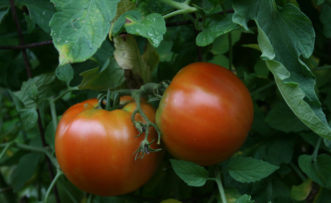A major reason for growing vegetables at home is to produce crops of a higher eating quality than may be otherwise available. A lot of comments and questions I have received from this platform is about harvesting. When is the right time and way to harvest my vegetables from my school/home garden?
For shipping and storage reasons, many commercially-grown vegetables are picked before they reach peak eating quality (maximum flavour and nutrition). A home gardener has the distinct advantage of harvesting a vegetable at its peak quality. Knowing exactly when a vegetable has reached its best eating quality can be difficult to determine, especially when for the first time growing a particular vegetable.
Most vegetables attain their best eating quality when allowed to ripen on the plant, but often this peak quality is reached before the vegetable is fully mature (i.e., cucumbers, okro and beans). As a result, many gardeners fall into the ‘bigger is better’ mindset and allow crops to stay on the plant too long. For instance, novice okra growers may leave pods on the plant too long in opting for a larger product. However, okra pods quickly become over-mature and woody, rendering them inedible.
Most seed catalogues and labels list days to maturity for crops. While this may be a helpful tool, especially when scheduling seed-starting dates, succession crops, etc., it is not always reliable for calculating precise harvest dates. There are many factors that influence a harvest date, including soil fertility, precipitation and temperature. As a result, actual ‘days to maturity’ may be different from year to year. Therefore, a gardener needs to be aware of the subtle clues which indicate a vegetable is ripe for the picking. See the list below for tips on harvesting some common vegetables.
Almost all vegetables are best when harvested early in the morning. Overnight, vegetables regain moisture that they lost during the day, and starches formed during the day may be converted to sugars during the evening. These traits make morning-harvested produce crisper, juicier and sweeter. If you cannot harvest in the morning, produce should be kept out of direct sunlight and cooled as soon as possible to slow degradation. Vegetable quality is the highest at the moment of harvest and begins to decrease rapidly afterward.
Be gentle with garden plants while harvesting vegetables. If vegetables are not easily removed when twisted or pulled, use a knife, scissors or hand pruners. These tools help prevent tearing or breaking of a plant, which could lead to disease infection. Also, be careful not to step on stems or foliage of the plants while harvesting. Future harvests depend on a healthy parent plant. Finally, frequent picking is essential for prolonging the harvest. A plant’s goal is to reproduce; therefore, if its fruit fully mature on the plant, there is no reason for it to continue flowering, which means fruit production will halt.
Storage times provided below are for freshly harvested produce. Store-bought produce will likely have shorter storage times due to the time between harvest and being purchased in the store.
Harvesting Tips for Common Vegetables
Cabbage: Harvest when the head is solid, firm, and has reached adequate size depending on the variety and growing conditions. Once cut, move it out of the sun as soon as possible. Cabbage will ‘sunblister’ and lose weight in direct sunlight. Cabbage can be stored in the refrigerator for a month or more.
Carrot: Harvest roots when they reach the desired size (typically ¾ to 1-inch diameter). Fall carrots, if mulched, may be left in the ground and dug as needed over winter. Otherwise, carrots with tops removed can be stored for 4 to 6 months at 33 °F and high humidity to prevent wilting. Carrots with tops left on will not store as long.
Cucumber: Begin harvesting when cucumbers are about 2 inches long up to any size, but before their flesh becomes bitter, seeds harden or skins begin to yellow. Pickling types should be harvested between 2 and 6 inches in length, while slicing and burpless types are typically picked between 6 and 10 inches long. Pick as frequently as necessary to avoid oversized fruit and to encourage continued production. Harvest the fruits by cutting stems with a sharp knife or pruners. Cucumbers can be stored in the refrigerator for about a week.
Eggplant: The fruits of eggplant may be harvested at any time after they have reached sufficient size, but should be removed from the plants before the flesh becomes tough and seeds begin to harden. Fruit should be large, shiny, and uniform in colour. The fruit is ripe when the side of the fruit is pressed slightly with a thumbnail and an indentation remains. Harvest the fruit by cutting stems with a sharp knife or pruners. Eggplant will store in the refrigerator for a week.
Lettuce-Leaf: Harvest entire head or individual outer leaves before hot weather causes lettuce to turn bitter and bolt. It can be used as soon as plants are 4 to 6 inches tall. Bibb lettuce is mature when leaves begin to cup inward to form a loose head. Cos or Romaine is ready to use when the leaves have elongated and overlap to form a fairly tight head about 6 to 8 inches tall. Store in the coolest area of the refrigerator. Leaf, Bibb, and Romaine will store as long as 4 weeks if the leaves are dry when bagged.
Okra: Harvest when pods are 2 to 3 inches long. At this stage, the pods are still tender. Larger okra pods tend to be tough and fibrous. Round-podded okra varieties remain tender at larger pod sizes and are good to use for slicing and freezing. Okra grows very fast; therefore, it must be harvested every 2 days. Do not allow pods to mature on the plant because this will inhibit flower production and thus reduce the plant’s total productivity. Handle okra carefully because pods bruise easily. Okra can be stored in the refrigerator for about 7 days. Okro pods are best when picked at 2 to 3 inches long.
Onion, Green: Harvest green onions when tops are 6 to 8 inches high and before flower stalks form. Green onions can be stored in a plastic bag in the refrigerator for up to 2 weeks.
Pepper, Hot: Hot peppers may be picked green or allowed to ripen and change colours on the plant. Entire plants may be pulled and hung just before fall frosts. Jalapeno peppers should be harvested when the fruit turns black-green. Peppers can be stored in the refrigerator for 2 to 3 weeks.
Pepper, Sweet: Harvest sweet peppers when they reach full size, the fruit walls are firm, and the peppers are still in the green or yellow state, or allow them to ripen further for red or orange peppers. The stems of pepper plants are brittle. When harvesting the fruit, cut the stems instead of pulling to avoid breaking branches. Varieties turn from green to red, yellow, or chocolate when allowed to mature on the plant. Bell peppers can be left on the plant to turn colour; however, they should be picked as soon as they change to the desired colour. Fully coloured peppers are sweeter than green peppers. Store peppers in plastic bags in the refrigerator for 2 to 3 weeks.
Using pruners, scissors or a knife to harvest may be better for some plants than breaking stems by hand
Tomato: Pick fruit when it is fully vine-ripened but still firm; most varieties are dark red, but many other colours are possible depending on the variety. Harvested tomatoes should be placed in the shade. If immature (green) fruit is harvested do not refrigerate, as this inhibits ripening. Instead, ripen them at 70°F. Light isn’t necessary for ripening green tomatoes. Green tomatoes can be stored at 50 to 70°F for one to three weeks. Ripe tomatoes can be stored at room temperature (70°F) or in the refrigerator for 4 to 7 days. However, refrigeration can reduce flavour and cause the tomatoes to develop a mealy texture.
Although they still have a little green, these tomatoes are ready to be harvested. Finish ripening them at room temperature.
For more information on LetsGoFarming, join us on our social media platforms @letsgofarmingtv @lgftv










